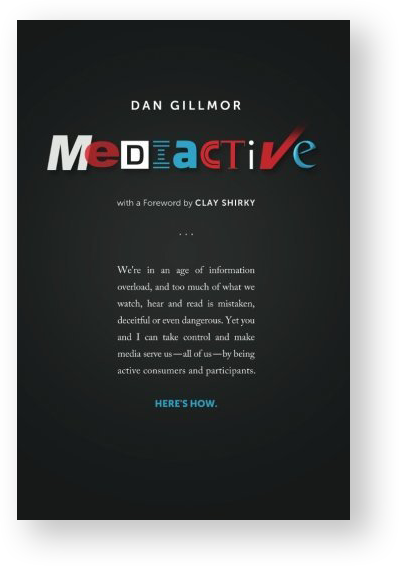Here we go!
This short course is based in part on Dan Gillmor’s book Mediactive. The book was written in 2009, but the principles are just as relevant today. As Dan says in the introduction to the volume:
Welcome to 21st century media. Welcome to the era of radically democratized and decentralized creation and distribution, where almost anyone can publish and find almost anything that others have published. Welcome to the age of information abundance.
And welcome to the age of information confusion: For many of us, that abundance feels more like a deluge, drowning us in a torrent of data, much of whose trustworthiness we can’t easily judge. You’re hardly alone if you don’t know what you can trust anymore.
But we aren’t helpless, either. In fact, we’ve never had more ways to sort out the good from the bad: A variety of tools and techniques are emerging from the same collision of technology and media that has created the confusion. And don’t forget the most important tools of all — your brain and curiosity.
This isn’t solely about being better at consuming information. As Clay Shirky, vice provost at New York University, put it in his foreword to the book:
Dan doesn’t make upgrading the sources, or the gatekeepers, or the filters — or any other “them” in the media ecosystem — his only or even primary goal. Dan wants to upgrade us, so we can do our own part. He wants us to encourage media to supply better information by helping us learn to demand better information. And he wants us to participate as creators.

This is about how we — all of us — need to be active users of media, as consumers and creators, and do that with integrity.
The three-week Mediactive course is a key part of the News Co/Lab’s mission to scale media literacy efforts within three key constituencies: education, and the media and technology industries. In just a couple hours a week, the course goes beyond the principles set forth in the book to include tangible tips and tools to help you make sense of the media deluge. In addition to the content found on this website, the course includes videos and interactive activities to test your knowledge as you go.
First, a brief history of media
It has taken millennia for humanity to produce “democratized” media — that is, a world in which the tools of media creation are widely available while widespread networks give people access to an almost unlimited amount of information that they, not centralized entities, choose for themselves. When early humans started drawing on the walls of caves, they created a lasting record of things that mattered. Stationary cave walls gave way to rock and clay tablets, which in turn were supplanted by papyrus and animal-skin documents, including scrolls. Early books — single editions created by scribes — came next, setting the stage for Media 1.0: the printing press.
Moveable type and the printing press, taking its early and most famous form as Gutenberg’s Bible, liberated the word of God from the control of the priests. This was humanity’s first profound democratization of media. Printing presses spread the words of individuals to many readers, in books, pamphlets, newspapers, magazines, and more. Regimes shook, and some fell. Civilizations changed irrevocably.
When the telegraph first moved information over long distances at the speed of light, we’d hit a new turning point. Call it Media 1.5 — the information moved from point to point but not directly to the people. This led to the next epochal shift.
Broadcasting is Media 2.0: mass media traveling long distances instantaneously. The radio brought news and information, plus the sound of the human voice, with an immediacy that led to the rise of both the great and the wicked. Franklin Roosevelt did much to calm a troubled nation with his fireside chats, while Hitler used radio, among other media, to pull his nation into outright savagery.
Television engaged eyes in addition to ears, adding the moving images of film to radio broadcasting’s immediacy. It was a huge shift (Media 2.5), but not as great as what was to come.
The internet is Media 3.0, combining all that has come before and extending it across the web of connections that includes everything from email to web browsing to social media It is radically democratized media — for both access and creation — in ways that we are only now beginning to understand well. But with this opening of what had been a mostly closed system, possibilities emerge, literally without limit. Those possibilities are not all positive.
The early commercial Internet, and especially the early web, wasn’t very interactive. That changed rapidly, as we connected with various services (including shopping) where two-way conversations became the norm. Then came social media, where we are in many-to-many conversations that have had radical impacts, including a massive re-centralization of our communications under the control of a small number of giant companies.
This shift has been accompanied by a move toward what has been coined “surveillance capitalism” — a system in which we, the users of online media, become products being sold to others and where we are constantly spied on by a murky complex of advertising and technology companies, and governments leveraging data collected by those companies.
